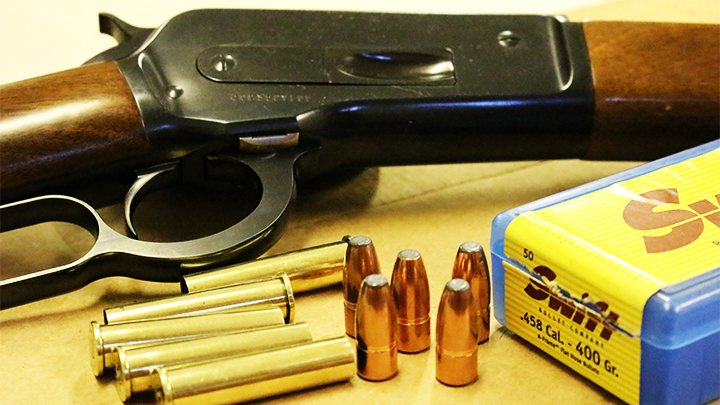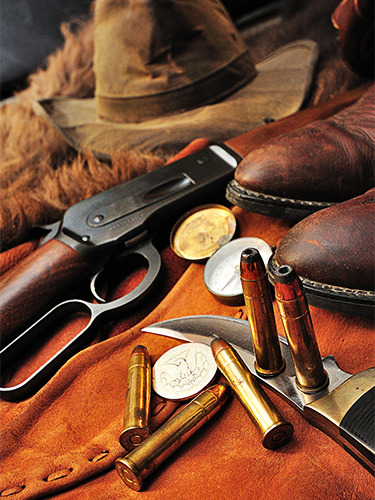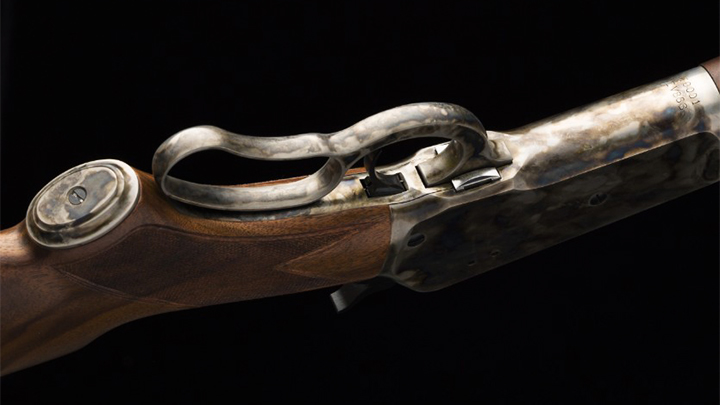Category: All About Guns

U.S.A. –-(AmmoLand.com)- Before the Biden-Harris administration took over the White House, the Bureau of Alcohol, Tobacco, Firearms and Explosives usually revoked an average of 40 Federal Firearm Licenses (FFLs) per year. But, in the 11 months since Joe Biden declared war on “rogue gun dealers,” the ATF has revoked 273 FFLs – an increase of more than 500%. However, rather than targeting the true rogues, Biden’s ATF is revoking FFLs for the most minor of paperwork errors, which were never a concern for the ATF until Biden weaponized the agency.
“This has nothing to do with the ATF and everything to do with the DOJ,” said John Clark of FFL Consultants. Clark is a firearm industry expert who said the ATF announced the number of revocations at a recent Firearm Industry Conference.
“The vast majority of the ATF don’t like this any more than the industry does,” he said. “It’s Biden.”
Clark and business partner John Bocker crisscross the country to help gun dealers fight back against Biden’s overreach – a service that is free to all members of the National Shooting Sports Foundation. Their mantra is: “Get it right the first time.”
“Our goal is to prevent an incident from occurring,” Bocker has said. “Our goal is prevention – get it right the first time. We are the proactive and preventative arm of the NSSF.”
Nowadays, they’re extremely busy. “I had three revocation hearings last week,” Clark said.
Key to the massive increase in revocations is Biden’s zero-tolerance for willful violations policy, which Clark said relies upon a new definition of willful. If a dealer makes a simple mistake, they can now lose their license, because the new definition of willful states that the dealer knew the law, but willfully chose to violate it anyway – regardless of whether it was an oversight, an error by an employee or a simple paperwork mistake.
“They have twisted negligence into willful,” Clark said. “These are not uncommon errors that we’re seeing. Things happen.”
On paper, Biden’s new policy seems clear:
Absent extraordinary circumstances that would need to be justified to the Director, ATF will seek to revoke the licenses of dealers the first time that they violate federal law by willfully.
- Transferring a firearm to a prohibited person
- Failing to run a required background check
- Falsifying records, such as a firearms transaction form
- Failing to respond to an ATF tracing request
- Refusing to permit ATF to conduct an inspection in violation of the law
However, Clark and Bocker are seeing these rules pushed far beyond the realm of common sense or fairness, and local gun dealers are paying the price.
For example, the transaction number for a NICS background check requires nine digits. If a gun dealer mistakenly omits a number, their license can be revoked for failing to run a background check. Under the Biden-Harris administration, there is no longer any room for human error.
Similarly, the ATF has started contracting out its trace requests, Clark said. He and Bocker have talked to a dealer whom the ATF accused of not complying with a trace request. They fault, they found, actually belonged to the ATF, which hadn’t updated its records from the contractors. Until this was clarified, the dealer was at risk of losing everything.
Their firm offers a free webinar for gun dealers, which addresses Biden’s policy.
ATF Breaking Federal Law
Biden first announced his zero-tolerance policy for “rogue gun dealers” in June of last year. He claimed these dealers were responsible for skyrocketing violent crime rates in major cities historically controlled by Democrats.
The violence wasn’t caused by weak prosecutors who refuse to hold criminals accountable, or gangs or underfunded police departments or by any combination thereof, he said. It was all the fault of “rogue gun dealers,” who Biden claimed willfully transfer firearms to prohibited persons, and/or refuse to cooperate with a tracing request from the ATF.
To vet Biden’s rogue gun dealer theory, the Second Amendment Foundation’s Investigative Journalism Project immediately sent a Freedom of Information Act (FOIA) request to the ATF, seeking the following:
Copies of documents that show the number of Federal Firearms Licensees (FFLs) and their state of residence, who have been prosecuted for willfully transferring a firearm to a prohibited person over the past three years (from June 23, 2018 to June 23, 2021.)
Copies of documents that show the number of Federal Firearms Licensees (FFLs) and their state of residence, who have been prosecuted for ignoring and/or refusing to cooperate with a tracing request from the BATFE, over the past three years (from June 23, 2018 to June 23, 2021.)
(Note: We did not seek the names or other identifiers of any FFL.)
We’re still waiting for a response.
In the 11 months since the FOIA request was filed, the ATF has not complied with the law. The ATF is in a trick-bag of sorts. They can comply with federal law and provide the documents, which will likely reveal that Biden’s rogue gun dealer policy is just a ruse, or they can continue to deny and delay the FOIA request even though their actions violate federal law.
Takeaways
If there is a dealer who transfers firearms to prohibited persons, fails to conduct background checks and ignores requests from the ATF to help trace firearms used in a crime, they should lose their FFL. I don’t know anyone who disagrees with that. However, these are not the type of dealers the ATF is targeting at Biden’s behest. The Biden-Harris administration has ordered the ATF to revoke FFLs for even the most minor of paperwork errors, solely to support its rogue-dealer myth.
There is no doubt Biden will soon hold a press conference touting the effectiveness of his zero-tolerance policy and the hundreds of “rogue gun dealers” whose licenses were revoked as a result. What he won’t mention is that none of the dealers who lost their livelihoods contributed to the skyrocketing violent crime rates of major metros. They were simply law-abiding men and women who made a minor paperwork error, which Biden has now criminalized as part of his ongoing war on our guns.
This story is presented by the Second Amendment Foundation’s Investigative Journalism Project and wouldn’t be possible without you. Please click here to make a tax-deductible donation to support more pro-gun stories like this.
About Lee Williams
Lee Williams, who is also known as “The Gun Writer,” is the chief editor of the Second Amendment Foundation’s Investigative Journalism Project. Until recently, he was also an editor for a daily newspaper in Florida. Before becoming an editor, Lee was an investigative reporter at newspapers in three states and a U.S. Territory. Before becoming a journalist, he worked as a police officer. Before becoming a cop, Lee served in the Army. He’s earned more than a dozen national journalism awards as a reporter, and three medals of valor as a cop. Lee is an avid tactical shooter.


We had been stalking the herd for the better part of the morning, when we finally saw the bull come wide to the left side of the herd. My father brought his rifle to shoulder, and sent a 400-grain Swift A-Frame into the base of the bull’s neck, precisely where the guide instructed, dropping the beast where it stood.
His smile was equally inspired by the bison he stood over—we were hunting the quarter-million-acre Triple U Ranch in South Dakota, where “Dances with Wolves” was filmed—and by one of his favorite rifles: a Browning Model 1886 in .45-70 Government.

That rifle Dad carried was released in 1986, as a centennial celebration of the release of one of John Browning’s finest designs, and one of the strongest lever-action rifles ever developed.
The Model 1886 was much stronger than the Model 1873 or Model 1876, using two vertical steel bars to keep that action closed and the bolt firmly in place; the receiver was also different in that it was long enough to handle the popular and plentiful .45-70 Government cartridge, among other powerful blackpowder cartridges like the .50-110 WCF, .45-90 (albeit with shorter bullets) and .40-82 WCF. Browning’s beefy lever gun would also prove to be strong enough to survive the transition to smokeless powder when fitted with a nickel-steel barrel, being chambered for the .33 Winchester in 1903. It was even chambered for the 32-gauge shotshell, available as a custom order.

In production from 1886 until 1935, the Winchester Model 1886 has that inimitable feel to its action; just working the lever gives the user an idea of its strength. The ’86 action locks up like a bank vault, and that strong action allowed me to handload those 400-grain A-Frames—seated over a healthy charge of Hodgdon’s BL-C(2)—to a muzzle velocity of just over 1800 fps from his 26-inch octagon barrel. Mind you, that is from a modern rifle, but it is indicative of the strength of the 1886.
A buckhorn rear sight, with a serrated elevator for vertical adjustments, could be drifted in its slot for windage adjustments, and the rifle was produced with a variety of front sights over the years of production. A tubular magazine—both full-length and half-length magazines were available—sits underneath the barrel, and is fed through a loading port on the right side of receiver.

The 1886 was available with a single trigger, though a double-set trigger was available. A two-piece walnut stock—predominately straight-gripped though also made with a curved pistol grip—rounded out the furniture, and was generally plain, except for the Sporting Deluxe variant, which was checkered front and rear. Some models had a straight shotgun butt, and others a curved steel buttplate. Like so many of John M. Browning’s other designs, the simplicity is a part of the elegance. There are some neat takedown models in both half- and full-magazines.
The 1886 was discontinued in 1935, when it was replaced by the Model 71 Winchester—itself based strongly on the 1886 action—chambered in the powerful .348 Winchester. While there is no denying the success of the Model 71, which was designed to be the premier lever-action rifle, like its bolt-action counterpart the Model 70, there is also no denying the importance of the 1886 in the progression of repeating rifles.
Browning released a pair of commemorative rifles in 1986; Dad bought the standard grade with blued metalwork and plain stock, and there was a High Grade version as well with a nickel-plated engraved receiver and checkered stock. Both were chambered in .45-70 Government.

Thankfully, Winchester has re-introduced the 1886 to its lineup, in several variations. There is the Model 1886 Deluxe Case Hardened comes with a curved pistol grip, checkered stock and case-hardened appointments and a 24-inch octagonal stock, chambered in .45-70 Government. The Model 1886 Deluxe has a similar conformation to the Case Hardened variant, except that it is available in .45-70 and .45-90, a new option for 2020. They share that classic crescent steel buttplate, which digs into your shoulder, but hey, that just comes with the territory.
The new Winchesters aren’t true replicas or reissues; they do have the tang safety common to the newer model Winchesters. But, they offer the 1886 experience to a whole new generation of shooters and hunters, with modern metallurgy, in a rifle capable of handling the modern, stout .45-70 loads like the Hornady 325-grain LeveRevolution at 2050 fps and the Buffalo Bore 400-grain load at 2000 fps.
There are so many excellent lever-action rifles to choose from, including the classic Model 1894 Winchester, the Model 1893 Marlin and Model 1892 Winchester, up through the more modern designs like the Marlin 336 and Winchester Model 88, to the Browning BLR, but to me, the 1886 Winchester remains at the top of the heap.
It is heavier than some of the other designs, but I like the heft and balance of the 1886. It settles down well for the shot, and even the heavier .45-70 loads are tolerable, though the points of that crescent buttplate can and will bruise your shoulder when shooting from the bench.

Whether new or vintage, having a Model 1886 in your safe is never a bad idea, and it makes a great choice for nearly any big game at ranges suitable for the big rimmed cartridges. I still enjoy shooting Dad’s Browning—now almost 35 years old—and enjoy his smile when he shoots it. I’m still on the hunt for an ’86 of my own, probably a vintage takedown, but who knows; there are so many cool variations one never knows what can be found in an old gun shop.
1. Battleships
Once thought to be the cornerstone of naval power, the advent of Naval Aviation and the rise of the aircraft carrier in WWII was the beginning of the end for the large-gunned ships of the line. Though battleships saw continuous combat in WWII and Korea, the US Navy was left without an active battleship upon the decommissioning of the USS Wisconsin in March 1958; the first time since 1895.
Most military enthusiasts are familiar with the Reagan administration’s 600-ship Navy and the reactivation of the battleships USS Iowa, Missouri, New Jersey and Wisconsin. USS New Jersey would be the first to fire her massive 16-inch guns at enemy targets again during the Lebanese Civil War from 1983-1984. USS Missouri and Wisconsin would return to combat in 1991 during the Gulf War. However, USS New Jersey was brought back into active service once before.

RELATED: HOW ONE ILL-ADVISED RADIO TRANSMISSION DOOMED THE BISMARCK
Following the beginning of Operation Rolling Thunder in 1965, the loss of US aircraft over Vietnam increased exponentially. The planes that took part in the sustained aerial bombardment campaign were exceptionally vulnerable to sophisticated Soviet-made surface-to-air weapon systems provided to the North Vietnamese.
In an effort to alleviate these air losses while still delivering ordnance payloads, USS New Jersey was brought out of mothballs in April 1968 and modernized for active service in Southeast Asia. The only active battleship in the world, New Jersey, joined the gun line off the Vietnamese coast on September 25. Five days later, she fired her first shots in over 16 years during an engagement against PAVN targets near the DMZ at the 17th parallel. She would go on to fire 14,891 5-inch shells and 5,688 16-inch shells during the war in support of ARVN, US and even Korean troops.
2. M14 Rifle
An evolution of the famed M1 Garand of WWII and Korea, the M14 battle rifle became the standard-issue rifle for the US military in 1959. Firing the 7.62x51mm NATO round, the M14 was meant to streamline logistics efforts by replacing the M1 Garand, M1903 Springfield, M1917 Enfield, M1 carbine, M3 submachine gun, M1928/M1 Thompson submachine gun, and M1918 Browning Automatic Rifle. While the M14 exhibited outstanding accuracy and stopping power in its semi-automatic setting, its full-power cartridge was deemed too powerful for the submachine gun role and its light weight made it difficult to control during automatic fire as a light machine gun.

RELATED: THE 4 GUNS USED TO MAKE THE LONGEST SNIPER KILLS IN HISTORY
Though the M14 was replaced by the M16 as the standard-issue rifle in 1968, it found a new role as a precision rifle platform. It served as the basis of the M21 Sniper Weapon System introduced in 1968 and M25 Sniper Weapon System introduced in 1991. Though both weapon systems have been largely replaced by the M24 Sniper Weapon System, the M14 lives on as the Mk14 Enhanced Battle Rifle. Introduced in 2002, the Mk14 is a truer reincarnation of the M14. Where the M21 and M25 were restricted to semi-automatic fire, designated as Sniper Weapon Systems and saw more restricted issuance as a result, the Mk14 sees the return of selective fire, the designation as a battle rifle for both designated marksman and close combat roles, and issuance by the Army to two riflemen per infantry platoon deploying to Afghanistan.
3. Guns on fighter planes
With the advent of radar-guided and heat-seeking air-to-air missiles, like the AIM-7 Sparrow and AIM-9 Sidewinder, and the new threat of high-altitude, long-range Soviet bombers, US air combat doctrine called for the elimination of gun armament on fighter-interceptor aircraft. Though dedicated attack and fighter aircraft like the A-4 Skyhawk, A-7 Corsair II and the F-8 Crusader retained 20mm cannons for ground attack and close-range aerial combat, interceptors like the F-86D Sabre, F-102 Delta Dagger and the F-4 Phantom II dispensed with any type of gun armament in favor of rockets and missiles. The idea during the late 50s and early 60s was that these types of aircraft would engage in long-range combat without visual contact of their target and, even if they did get close enough to see the enemy that the new Sidewinder missile would be able to dispense with a hostile fighter with ease.

RELATED: THIS IS WHY ADVANCED FIGHTERS STILL CARRY GUNS
This idea proved to be fatal for pilots over the skies of Vietnam. For Phantom II pilots in particular, who escorted bomber flights over North Vietnam, the lack of a gun often left them without offensive options during a dogfight. A Marine Corps General recalled, “Everyone in RF-4s wished we had a gun on the aircraft.” As any Top Gun fan can tell you, the American air-to-air kill ratio in Korea was 12:1. According to the US Naval Institute, the Navy’s kill ratio in Vietnam was just 2.5:1. The drop in kill ratio was attributed to poor missile accuracy at just 10% and lack of dogfighting skills. The latter resulted in the creation of TOPGUN while the former resulted in the addition of an external gun pod to the Phantom II. An internally mounted gun was incorporated on the later F-4E models.